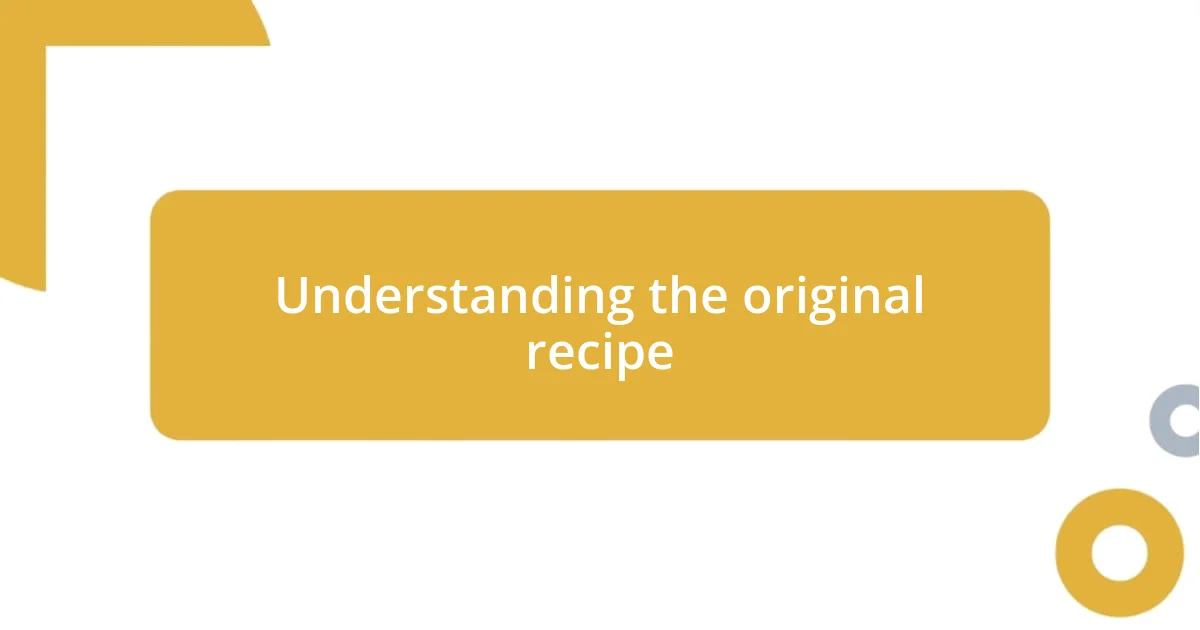Key takeaways:
- The process of adapting a cherished family sausage recipe allowed for exploration of flavors, techniques, and ingredient alternatives that honored tradition while inviting innovation.
- Family taste tests provided invaluable feedback, highlighting the importance of collaboration and shared experiences in refining the recipe and creating lasting memories.
- Sharing the adapted recipe with family and friends fostered connections and relationships, illustrating how food serves as a bridge across generations and enhances communal experiences.

Understanding the original recipe
The original sausage recipe in my family has been passed down for generations, making it a cherished part of our culinary heritage. I can still remember gathering around the kitchen table with my grandparents, watching them mix spices and meat with the same care that a painter shows when choosing colors. How can you not feel a connection to your roots when there’s love woven into every step of the process?
As I studied the recipe, I discovered that it wasn’t just a list of ingredients; it was a story waiting to be told. Each spice represented a memory, like the warm summer afternoons spent grilling with family or the chilly winter nights when we huddled around the stove. What makes a recipe truly special isn’t just the taste, but the emotions and traditions it holds.
I still find myself reflecting on why we used certain ingredients, like that specific blend of herbs that my great-grandmother insisted made all the difference. Could it be that these flavors were her way of imparting love and care? In understanding the original recipe, I’ve come to appreciate not just the flavor, but the history and affection behind each bite.

Identifying key flavors
Identifying the key flavors in my family’s sausage recipe was like peeling layers off an onion. I started by focusing on the classic ingredients: fennel, garlic, and pepper. Each one brought its own personality to the mix. Fennel provided this sweet, slightly licorice undertone. I can remember my mom always saying, “It’s the fennel that makes it sing.” It’s true; that hint of sweetness elevates the entire dish.
As I experimented with adapting the recipe, I realized that balancing these flavors was crucial. The rich, savory notes from the meat needed the brightness of the herbs. I experimented with adding a hint of crushed red pepper for that unexpected kick. When I took my first bite of this modified version, I could feel the warmth—almost as if I was back in my grandmother’s kitchen, surrounded by the comforting chatter of family. It’s fascinating how these elements work together to evoke memory and comfort.
This journey also led me to appreciate the textures. The combination of coarsely ground meat with finely chopped garlic created a delightful contrast. I learned that the way ingredients interact not only enhances flavor but also affects the overall eating experience. That first time I got the blend just right, I truly felt a sense of accomplishment, knowing that I was honoring my family’s culinary legacy while making it my own.
| Flavor | Description |
|---|---|
| Fennel | Sweet, slightly licorice flavor that adds depth |
| Garlic | Robust and aromatic; punctuates savory notes |
| Pepper | Provides heat; enhances the balance of flavors |
| Crushed Red Pepper | Adds an unexpected kick; invigorates the dish |

Exploring ingredient alternatives
When I began exploring ingredient alternatives, I was surprised at how many options were available without sacrificing the essence of the original sausage recipe. It reminded me of a time when I substituted turkey for pork for a healthier twist. I had some skepticism about whether it would bring the same depth of flavor, but I found that with the right seasoning, it created a lightness that still resonated with the familiar flavors of my childhood. That experience taught me that swapping out ingredients can lead to delightful surprises.
Here are a few ingredient swaps worth considering:
- Turkey or Chicken for Pork: Leaner options that can take on spices well due to their neutral flavor.
- Smoked Paprika for Black Pepper: Offers a smoky depth that enhances the savory profile.
- Fresh Herbs instead of Dried: Fresh thyme or basil can introduce a vibrant brightness compared to their dried counterparts.
- Quinoa or Lentils for Breadcrumbs: Great for adding texture and making the sausage more hearty and filling.
Exploring these alternatives not only expanded my culinary skills but also deepened my appreciation for how versatile the core flavors of my family’s recipe could be. Each modification felt like a little adventure, bridging the gap between tradition and innovation.

Adjusting cooking techniques
Adjusting cooking techniques has been one of the most enlightening parts of adapting my family’s sausage recipe. I distinctly remember the first time I decided to try sous vide cooking. Curious about how it might affect the flavor and texture, I set my bag of seasoned meat in a water bath instead of the traditional skillet. The result was astonishing—it was tender, juicy, and infused with all those lovely spices, giving me a new perspective on the cooking process.
I’ve also tinkered with frying temperatures and methods. One day, I experimented with baking instead of pan-frying. As the sausage links baked in the oven, I could smell that nostalgic aroma filling my kitchen. It felt different, yet just as delightful. The even heat allowed the flavors to meld beautifully without the fear of burning, and I realized that adjusting my technique didn’t diminish the recipe’s integrity; it enhanced it in unexpected ways.
Then there was the time I tried grilling instead of my usual sautéing. I was delighted by how the smoking grill added an earthy dimension that transported me back to summer family barbecues. The slight char complemented the spices perfectly. Have you ever thought about how slightly altering a technique can breathe new life into a cherished recipe? It’s a reminder that cooking is as much about exploration as it is about tradition.

Testing and refining the recipe
Testing my adapted sausage recipe was a journey filled with unexpected twists. After each batch, I would eagerly gather family members for a taste test, scribbling down their reactions like a mad scientist. The feedback was invaluable—when someone suggested a dash more garlic, I initially hesitated, thinking that might overpower the familiar flavors. However, I decided to trust their instincts, and when I increased the garlic, it added a depth that truly elevated the dish. Isn’t it fascinating how an ingredient we often take for granted can transform everything?
I also found myself adjusting the spice levels during our testing phase. On one occasion, a particularly adventurous cousin suggested a hint of chili flakes for a kick. I thought, “Why not?” So, I blended in a small amount, and the result was nothing short of magical. It fused a warmth that lingered beautifully—a reminder that experimenting isn’t just about making adjustments; it’s about discovering new dimensions in something that seems so familiar.
With each iteration, I made careful notes, treating my kitchen like a lab. There were times when I got it wrong, like once when I added too much smoked paprika, and the sausage ended up tasting more like a barbecue than anything else. I laughed it off when my family jokingly dubbed it “smokey disaster.” But those failures only fueled my determination. After all, isn’t finding the perfect balance what makes cooking an art? Each test felt like a puzzle piece falling into place, making the final product not just a recipe, but a story of exploration and togetherness.

Recording the final version
Recording the final version of my family’s sausage recipe felt like sealing a chapter in a cherished book. After countless trials and taste tests, I decided to sit down with my notes and compile all my findings. I realized that I wasn’t just documenting a recipe; I was preserving memories, laughter, and shared moments around the kitchen table. Have you ever experienced that exhilarating feeling of capturing something that means so much to you in writing? It’s a thrill like no other.
With each ingredient, I contemplated not only what it added to the recipe but also the stories attached to it. For instance, I remember how much my grandmother loved adding a pinch of nutmeg. She always said it brought warmth to the flavor, and although I was hesitant at first, including it made the final version feel like a warm hug from her. As I typed out the instructions, I couldn’t help but smile, knowing that this wasn’t just cooking but an homage to family traditions.
As I recorded the last few details, I thought about how sharing this version could spark joy and connection with others. I scribbled down not just the ingredients but also suggestions for personal tweaks, inviting readers to add their unique touch. Isn’t that what food is all about—making it your own while honoring the past? Finally publishing it felt like launching a little piece of my family’s history into the world, and I cherished every moment of that process.

Sharing with family and friends
There’s something undeniably special about sharing a meal with loved ones, and for me, the act of serving my adapted sausage recipe became a beautiful tradition. One family gathering, as I laid out a spread of freshly cooked sausages, I watched the faces around the table light up with anticipation. It warmed my heart to see my parents reminiscing about the original recipe while my kids eagerly dived into seconds. Isn’t it amazing how food can create bridges between generations?
As friends began to join our sausage nights, I realized the joy of sharing extended beyond family. One evening, a neighbor who had just moved in came by, curious about the smell wafting from our kitchen. I invited her to join us, and as we sat together, laughter and stories flowed much like the flavors mingling on our plates. I often think about how food has a way of breaking down barriers and fostering connections. Have you ever noticed how we bond over comfort food?
In these moments, I’ve learned that sharing isn’t just about passing around plates; it’s about sharing experiences and building memories. I referred to my sausage recipe as a delicious appetizer for deeper conversations. One unforgettable night, after trying a batch that incorporated hints of fennel, the table erupted with discussions about family cooking secrets and culinary quirks. It made me feel that my kitchen was not just a space for cooking, but a gathering place for love, laughter, and the sharing of stories.













